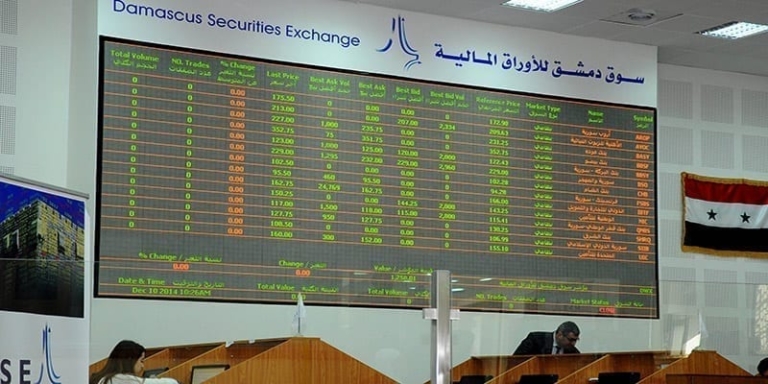
Close to nine years of civil war in Syria have resulted in the near total collapse of the country’s economy. From 2010 to 2017, it has declined by more than 70 percent. The Syrian regime blames international sanctions for the free fall of the Syrian pound and the lack of state services. Little mention is made of the widespread infrastructural damage after years of war, diminished domestic consumption and production, reduced subsidies, and dislocation of communities. In addition, high inflation, a weak national currency (the pound, or lira), and increased central bank intervention to support government spending on fighting the civil war have caused dwindling foreign exchange reserves and threaten to worsen the daily lives of Syrians––as if anything more could. Indeed, if the Syrian government fails to address the profound underlying economic problems, Syria may be looking at a quick and downward spiraling trend that will obviate whatever gains the Syrian army may have made against the opposition since 2011.
The Role of the Central Bank of Syria
The Central Bank of Syria (CBS) is the second oldest in the region after the Central Bank of Egypt, which was set up in 1863. Syria’s bank was established in 1953 and started operations in 1956. Like similar institutions around the world, the CBS issues bank notes, controls the money supply and banks, and acts as the fiscal agent of the government. It effected the separation of the Syrian lira from the French franc (France was the colonial power occupying Syria until 1946). And like others around the world, the bank was supposed to be separate and independent politically and to maintain monetary independence. The bank’s website still maintains that its function is to supervise the macroeconomic policy of the state, maintain the exchange rate, and control inflation.
One of the main issues in the authoritarian systems of developing or low-income countries like Syria is the lack of accurate statistics. Authorities often consider such information a national security issue. When the Syrian Central Bureau of Statistics––which is supposed to provide all the numbers that reflect the state of the Syrian economy––issues its reports, most independent scholars argue that its numbers are fabricated and inaccurate. In fact, the government is viewed as having published the statistics for political reasons, which makes them unreliable as a basis for an honest assessment of the economy. In Syria’s case, the Bureau has not published essential data about economic growth and the unemployment rate despite the fact that these are part of its mandate.
But a Trading Economics report listed economic growth in Syria in 2017 at 1.9 percent, which appeared to be a rebound from a -4.0 percent figure in 2016. A 2017 CIA report estimated the unemployment rate to have reached 50 percent, which was unchanged from 2016. Today’s collapse of the Syrian pound further illustrates the bank’s failure to protect the national currency; on January 18, 2020, the lira traded at almost 1,200 to the dollar. It is noteworthy that in 2011, the lira traded at 47 to the dollar. Such a free fall has led to a severe drop in the purchasing power of Syrian citizens, thus increasing the suffering of those who lack basic state services like drinking water, electricity, gas, and fuel during this tough winter.
Part of the problem has been the decline in Syria’s foreign currency reserves, specifically the dollar. Before the start of the war in 2011, reserves stood at $16-18 billion; but they dwindled by about a third by the end of that year. In 2015, the World Bank estimated that the country’s foreign reserves stood at $700 million, a level that has not improved since then and one that basically cannot buttress any bank effort to prevent the decline of the pound. Additionally, many blame part of the problem on developments in Lebanon where banks are limiting access to dollar deposits, including to Syrian depositors.
In addition to the widespread destruction and the disruption of all economic activities in the country, two specific developments have limited the government’s ability to influence the situation. First, international sanctions on the regime have limited the ability to secure foreign funds and hard currency, thus inhibiting external trade. In 2017, Syria’s exports were only $1.85 billion and imports stood at $6.279 billion, necessitating the intervention of the central bank, via its use of reserves, to protect the local market and currency. Second, Syria has lost control over its oil in the northeast, an area that is currently under the control of American forces in the region, depriving Damascus of needed energy resources and increasing its reliance on illicit imports from Iran, among other countries. To try to ameliorate the decline of the national currency, the Syrian government has issued directives to enforce the use of the pound in large and small transactions. It also set the exchange rate at 434 pounds to the dollar, a level that cannot prevent illegal trade by underground exchange manipulators.
The Threat to Ordinary Syrians
The continuing hemorrhage—and indeed collapse—of the Syrian national currency primarily affects the purchasing power of ordinary Syrians. With widespread unemployment in Syria and the displacement of millions of Syrians inside and outside the country, there may be no recourse for halting this collapse or addressing poverty. In 2019, the United Nations Development Programme estimated that 83 percent of Syrians already live below the poverty line and that close to 12 million are in immediate need of assistance, a situation that will only get worse in the future if current conditions continue.
The Syrian government may think that its superiority on the battlefield is the most important development in the last few years. The Syrian army, buttressed by Russian equipment and troops and Iranian-supported militias, is currently waging what it sees as its last battle against the opposition in Idlib in the northwest. But in reality, Syria’s toughest battle is in how to handle the collapse of the national economy and the required reconstruction of the country. Considering the paucity of funds in its central bank to support the national currency, coupled with the absence of regional and international donors for reconstruction, the latter battle is likely to be the most difficult of them all.


